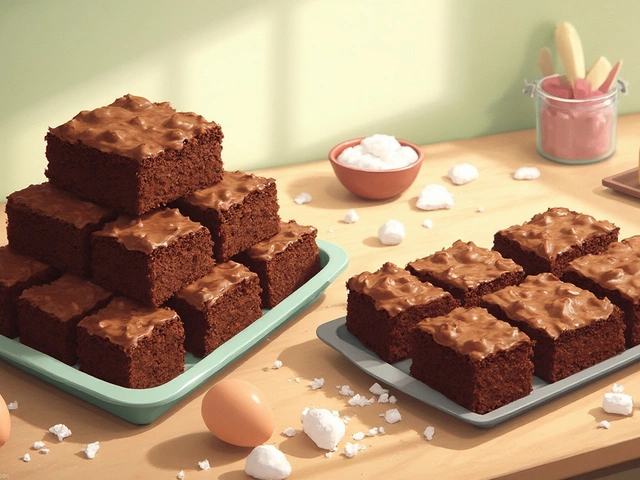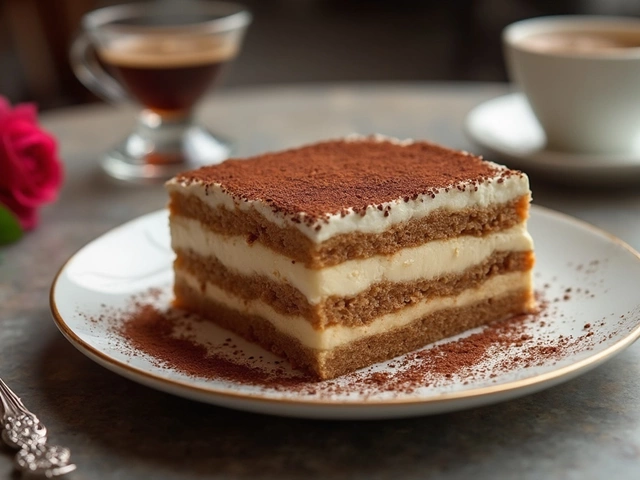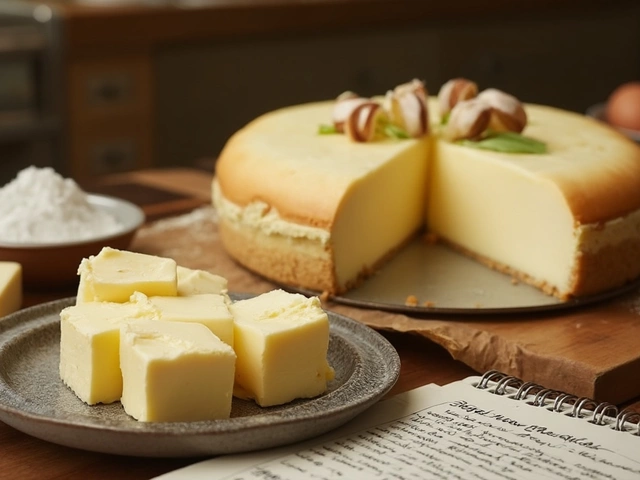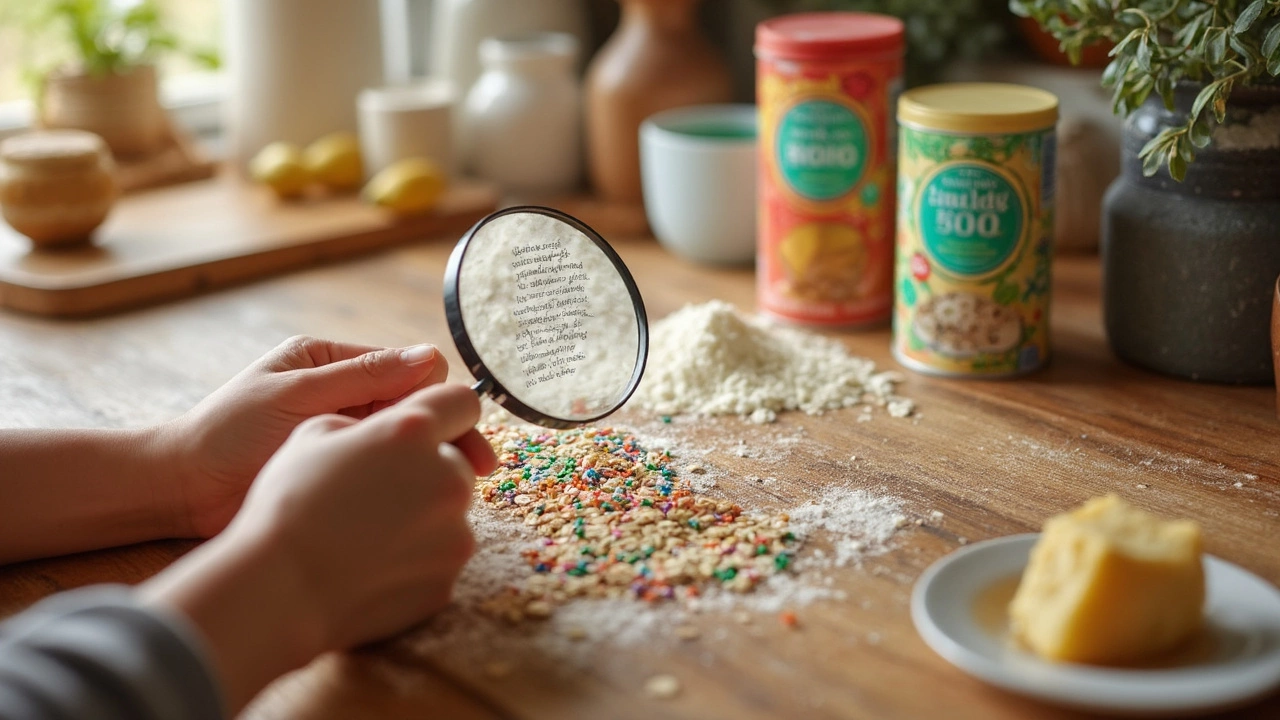
Gluten has a knack for showing up in places you'd never think to look, especially when you're focused on gluten-free baking. Sometimes the flour is easy to avoid, but what about those tiny ingredients listed in six-point font on the back of a cake mix box? Trust me, eating gluten by accident happens fast, and it only takes one overlooked label to ruin your day (or your stomach).
If you're making cakes for someone with celiac disease or a gluten intolerance, the usual culprits like wheat flour and regular cake mix are obvious no-gos. But did you know some brands of baking powder and even sprinkles have gluten tucked away inside? Even flavorings or thickeners can sneak gluten into your recipe.
Knowing which ingredients are the worst for gluten gives you a head start. Next time you reach for cookie crumbs for a base or toss in a handful of oats, double-check: are they marked gluten-free? Only certified options are reliably safe.
- Where Gluten Loves to Hide
- Worst Offenders in Baking
- Sneaky Sources in Store-Bought Cakes
- Spotting Hidden Gluten in Labels
- Smart Swaps for Gluten-Free Cakes
Where Gluten Loves to Hide
Gluten is sneaky and can stick around in foods and ingredients that look innocent at first glance. For anyone sticking to a gluten-free cake routine, you need to know gluten isn't just hanging out in bread and pasta. In fact, it can show up in your baking supplies, and even things you’d never think to question.
So, where should you keep your guard up? Here are some top places gluten likes to hide:
- Worst foods for gluten include processed cake mixes, unless they’re marked gluten-free. The "enriched wheat flour" in regular flour mixes is loaded with gluten.
- Watch out for malt extract—it gets tossed into many cake flavorings and it’s made from barley, a gluten-heavy grain.
- Oats can be a risky bet because they're often processed in the same facilities as wheat, unless the label says “certified gluten-free.”
- Commercial sprinkles and colored sugars sometimes use wheat-based binders or fillers, especially in bright specialty mixes.
- Some brands of baking powder, powdered sugar, and even pre-made frostings sneak in wheat starch or gluten as anti-caking agents.
Feeling suspicious about an ingredient? Always check the label. If you see anything odd like "modified food starch" or "hydrolyzed vegetable protein," don’t assume they’re gluten-free until you research the source. Certain brands even use wheat in stuff like pudding mix—which can ruin a gluten-free cake without warning.
| Item | Typical Risk | Safe Label to Look For |
|---|---|---|
| Oats | High (cross-contamination) | Certified Gluten-Free |
| Sprinkles | Medium | Gluten-Free Marked |
| Baking Powder | Low (depends on brand) | Wheat-Free, GF Symbol |
| Flavorings/Extracts | Medium | Gluten-Free |
| Store-Bought Frosting | Medium | Gluten-Free |
One study found that up to 1 in 3 processed baking ingredients have a risk of cross-contamination or hidden gluten, even when “wheat” isn’t the main word on the label. That’s why going straight to certified gluten-free products (and keeping an eye out for sneaky additives) protects you best.
Tip: Always re-check ingredients for your favorite brands—even if they used to be safe, manufacturers sometimes change recipes and add gluten without clear warnings.
Worst Offenders in Baking
If you think going gluten-free is as easy as swapping out flour, think again. In the world of baking, gluten likes to show up in places you probably wouldn't expect. Sure, wheat flour grabs all the attention—but it's sneaky little siblings are the real troublemakers for people avoiding gluten.
Wheat flour is the main villain, but don't sleep on the other grains. Rye and barley are just as loaded with gluten and sometimes pop up in specialty flours or flavor enhancers, especially in chocolate cakes. Another shocker? Spelt. It sounds healthier, but it’s totally off-limits for anyone avoiding gluten.
| Ingredient | Why It’s a Problem | Gluten-Free Alternatives |
|---|---|---|
| All-purpose flour | Main source of gluten in most cakes | Almond, coconut, rice, or certified gluten-free flour blends |
| Baking powder or baking soda (some brands) | May contain wheat starch for anti-caking | Brands labeled gluten-free |
| Malt extract/malt syrup | Derived from barley, heavy in gluten | Brown rice syrup or maple syrup |
| Oats (unless certified GF) | Often contaminated during processing | Oats labeled gluten-free |
| Sprinkles/decorations | May use wheat flour or gluten in coating | Brands certified gluten-free |
Cross-contamination is a huge issue too. If your kitchen mixer has a dusting of leftover cake, it only takes a speck to make a difference. According to the Celiac Disease Foundation, “Even tiny amounts of gluten—think less than 20 parts per million—can trigger symptoms in sensitive people.”
This is why home bakers have to be so careful—gluten-free means every single ingredient, tool, and countertop needs attention.
— Celiac Disease Foundation
Also, watch out for vanilla extract and other flavorings. While most are safe, some cheaper brands sneak in gluten as a carrier. Always read labels and double-check. Your safest bet is sticking with major brands that say "gluten-free" right on the bottle.
- Always clean your baking tools and surfaces before starting.
- Buy ingredients marked "certified gluten-free."
- Store your gluten-free flours and baking supplies separate from regular ones.
Catching these sneaky sources before they hit the bowl saves you from baking a disaster and keeps your gluten-free cakes safe for everyone at the party.
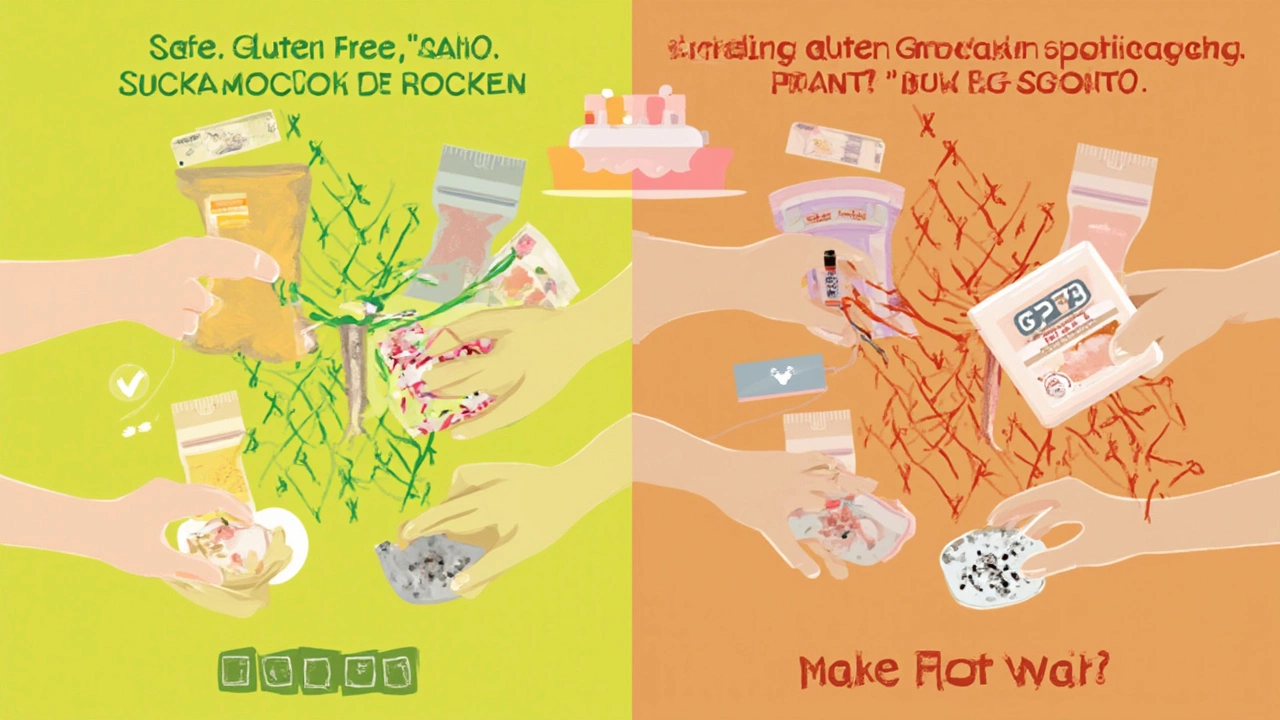
Sneaky Sources in Store-Bought Cakes
If you think grabbing a cake labeled "gluten-free" at the store means you’re safe, think again. Cross-contamination is a serious issue in commercial bakeries, especially when the same equipment churns out regular and gluten-free snacks all day long. The worst foods for gluten are often the ones you didn’t even realize had any risk.
Let’s look at some of the most common hidden pitfalls found in store-bought cakes:
- Decorations and Sprinkles: Fun toppings like sprinkles, candy pearls, and even edible glitter are sometimes made using wheat starch or processed in facilities that handle gluten.
- Fillings and Frostings: Pre-made fillings (like caramel, custard, or jam) might use wheat as a thickener. The same goes for some commercial icing that needs extra structure or shelf-life.
- Oats and Flours: Even if a cake uses oat flour or oats, these can be cross-contaminated unless they’re specifically certified gluten-free. Regular oats are a huge red flag.
- Binders and Stabilizers: Modified food starch, malt extract, or flavorings are sometimes used to bulk up cakes cheaply. If the starch is from wheat or the malt from barley, there’s gluten there.
- Pre-packaged Mixes: A lot of mixes say "wheat-free" but don’t guarantee full gluten-free standards because of cross-contact during the packaging stage.
Spotting gluten in a store-bought cake can be tricky when reading the labels. Just because the word “gluten” isn’t there doesn’t mean it’s absent. Here’s a quick chart showing common sneaky sources and their gluten risk:
| Ingredient/Item | Hidden Gluten Risk? | Safer Option |
|---|---|---|
| Sprinkles | Often high | Certified gluten-free brands |
| Oats/Oat Flour | Very high unless certified GF | Only certified gluten-free oats |
| Malt Extract | Contains gluten | Check for malt-free or barley-free |
| Custard/Fillings | Sometimes thickened with wheat | Read labels; stick to transparent brands |
Here are a couple of simple tips before you pick up that bakery "gluten-free" cake:
- Ask the bakery about cross-contamination—do they bake gluten-free cakes in a separate area?
- Look for certified gluten-free labels. If you don’t see one, it’s not guaranteed safe.
- If ingredients aren’t listed, pass. Transparency is your friend.
Piecing through all this sounds overwhelming, but you get used to it. Once you know these sneaky ingredients and risks, you’ll feel a lot more confident navigating the cake aisle.
Spotting Hidden Gluten in Labels
This part can get tricky—because gluten doesn’t always show up with a big red warning on the box. Sometimes it’s hiding behind odd ingredient names or vague terms. If you want your gluten-free cakes truly safe, get ready to do some detective work in the grocery aisle.
The number one tip is: don’t trust packaging that just says "wheat-free" or "no wheat added." Gluten can still be in rye, barley, or certain specialty flours. Always look for the full words “gluten-free.” If in doubt, skip it.
Watch out for ingredient names like:
- Modified food starch (if it’s not labeled gluten-free, it could be made from wheat)
- Malt (usually made from barley, so a no-go)
- Hydrolyzed vegetable protein (sometimes from wheat)
- Textured vegetable protein (can be wheat-based)
- Maltodextrin (if it’s not specified where it comes from, in some regions, it might be wheat-derived)
It doesn’t stop there. Even flavors or colorings can sometimes contain gluten, especially if they’re “natural” or “artificial” flavors and the source isn’t explained. Bulk sprinkles and some brands of chocolate chips, for example, might contain wheat flour to prevent clumping.
If you’re baking for anyone with celiac disease or gluten intolerance, always triple-check for the worst foods for gluten in ingredient lists. When in doubt, hit up the brand’s website or call their customer service line—it’s honestly worth the extra two minutes.
Pro tip: products labeled "made in a facility that processes wheat" can be risky for people with high sensitivity. A safe cake is a great cake, so don’t take shortcuts here.
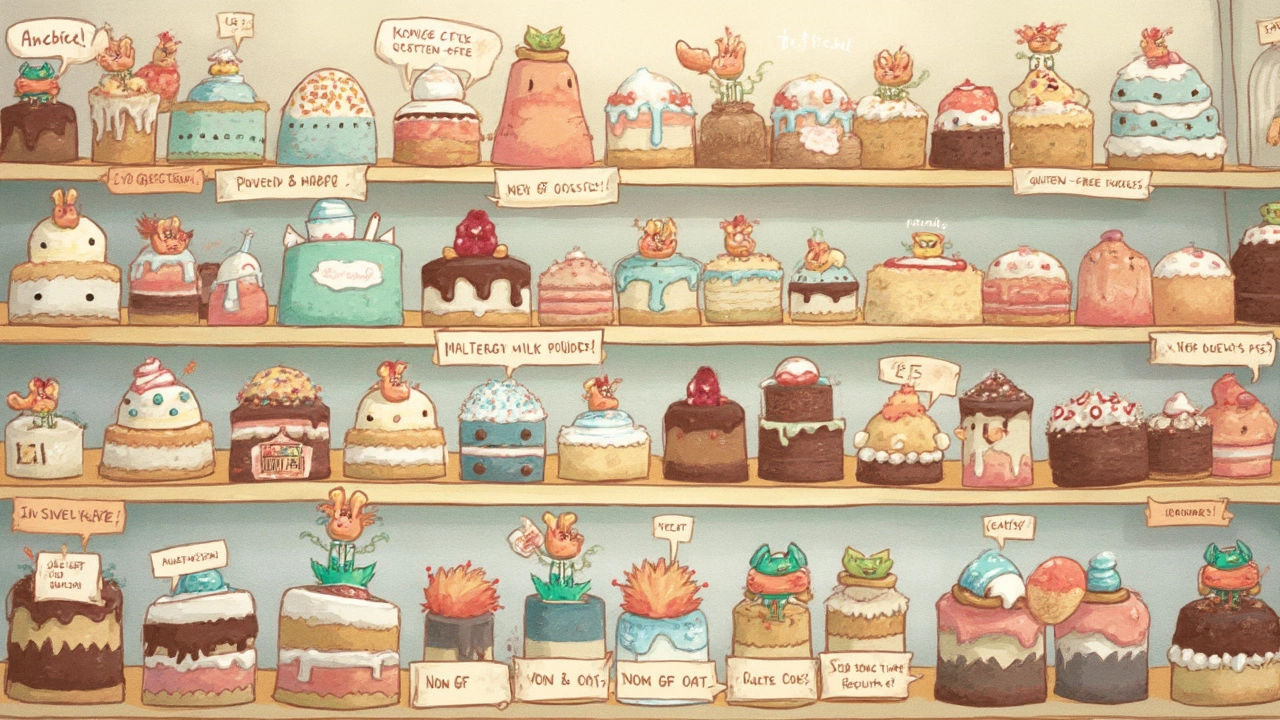
Smart Swaps for Gluten-Free Cakes
When you’re after tasty gluten-free cakes but want to dodge gluten landmines, the secret is making a few clever ingredient swaps. Some flours and add-ins don’t just work – they actually make your cakes better. You’ll skip the gut aches and nobody will guess it’s gluten-free.
- Flour swap: Instead of using wheat flour, go for blends using rice flour, potato starch, and tapioca starch. Brands like King Arthur and Bob’s Red Mill have premixed blends that work well for cakes. Almond flour and coconut flour can make cakes moist, but you might need to add a little extra liquid so things don’t get crumbly.
- Baking powder: Not all baking powders are gluten-free. Always check that it’s labeled gluten-free. Clabber Girl and Rumford both make safe options in the U.S.
- Oats: Regular oats are often contaminated with wheat during processing. Only use certified gluten-free oats if your recipe calls for them.
- Flavorings and thickeners: Vanilla extract and cocoa powder are usually safe, but cheap vanilla-flavored syrups and some thickeners (like modified food starch) can contain gluten unless labeled otherwise.
- Bread crumbs and bases: If the recipe has a base (like cheesecake), swap in gluten-free cookie crumbs or nuts instead of graham crackers. Gluten-free digestive biscuits work great too.
One thing lots of people don’t know: gluten-free cakes dry out faster than regular ones. To keep things soft, you can add an extra egg or try applesauce or yogurt. These make the crumb softer and help hold cakes together.
Check out this quick reference table for common gluten-filled ingredients and what to swap them for:
| Ingredient | Gluten-Free Swap | Notes |
|---|---|---|
| Wheat flour | GF flour blend, almond, coconut flour | Adjust liquid as needed |
| Baking powder | GF-labeled baking powder | Hidden gluten risk |
| Graham crackers | GF cookies, GF digestive biscuits | Great bases for cheesecakes |
| Oats | Certified GF oats | Avoid regular oats |
| Thickeners (wheat starch) | Cornstarch, arrowroot | Label check is a must |
Take it one ingredient at a time. Once you get used to these swaps, gluten-free baking feels way less intimidating. Plus, your cakes won’t just be safe—they’ll taste good too.

